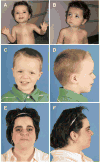20p12.3 microdeletion predisposes to Wolff-Parkinson-White syndrome with variable neurocognitive deficits
- PMID: 18812404
- PMCID: PMC2680125
- DOI: 10.1136/jmg.2008.061002
20p12.3 microdeletion predisposes to Wolff-Parkinson-White syndrome with variable neurocognitive deficits
Abstract
Background: Wolff-Parkinson-White syndrome (WPW) is a bypass re-entrant tachycardia that results from an abnormal connection between the atria and ventricles. Mutations in PRKAG2 have been described in patients with familial WPW syndrome and hypertrophic cardiomyopathy. Based on the role of bone morphogenetic protein (BMP) signalling in the development of annulus fibrosus in mice, it has been proposed that BMP signalling through the type 1a receptor and other downstream components may play a role in pre-excitation.
Methods and results: Using the array comparative genomic hybridisation (CGH), we identified five individuals with non-recurrent deletions of 20p12.3. Four of these individuals had WPW syndrome with variable dysmorphisms and neurocognitive delay. With the exception of one maternally inherited deletion, all occurred de novo, and the smallest of these harboured a single gene, BMP2. In two individuals with additional features of Alagille syndrome, deletion of both JAG1 and BMP2 were identified. Deletion of this region has not been described as a copy number variant in the Database of Genomic Variants and has not been identified in 13 321 individuals from other cohort examined by array CGH in our laboratory.
Conclusions: Our findings demonstrate a novel genomic disorder characterised by deletion of BMP2 with variable cognitive deficits and dysmorphic features and show that individuals bearing microdeletions in 20p12.3 often present with WPW syndrome.
Conflict of interest statement
Figures



Similar articles
-
Microdeletion 20p12.3 involving BMP2 contributes to syndromic forms of cleft palate.Am J Med Genet A. 2011 Jul;155A(7):1646-53. doi: 10.1002/ajmg.a.34063. Epub 2011 Jun 10. Am J Med Genet A. 2011. PMID: 21671386 Free PMC article.
-
A 8.26Mb deletion in 6q16 and a 4.95Mb deletion in 20p12 including JAG1 and BMP2 in a patient with Alagille syndrome and Wolff-Parkinson-White syndrome.Eur J Med Genet. 2008 Nov-Dec;51(6):651-7. doi: 10.1016/j.ejmg.2008.07.012. Epub 2008 Aug 15. Eur J Med Genet. 2008. PMID: 18775522
-
Alagille syndrome with deletion 20p12.2-p12.3 and hypoplastic left heart.Clin Dysmorphol. 2007 Oct;16(4):241-6. doi: 10.1097/MCD.0b013e3282358d21. Clin Dysmorphol. 2007. PMID: 17786115
-
Renal involvement and the role of Notch signalling in Alagille syndrome.Nat Rev Nephrol. 2013 Jul;9(7):409-18. doi: 10.1038/nrneph.2013.102. Epub 2013 Jun 11. Nat Rev Nephrol. 2013. PMID: 23752887 Review.
-
[From gene to disease: arteriohepatic dysplasia or Alagille syndrome].Ned Tijdschr Geneeskd. 2003 Jun 21;147(25):1213-5. Ned Tijdschr Geneeskd. 2003. PMID: 12848056 Review. Dutch.
Cited by
-
The genetics of attention deficit/hyperactivity disorder in adults, a review.Mol Psychiatry. 2012 Oct;17(10):960-87. doi: 10.1038/mp.2011.138. Epub 2011 Nov 22. Mol Psychiatry. 2012. PMID: 22105624 Free PMC article. Review.
-
Microdeletion 20p12.3 involving BMP2 contributes to syndromic forms of cleft palate.Am J Med Genet A. 2011 Jul;155A(7):1646-53. doi: 10.1002/ajmg.a.34063. Epub 2011 Jun 10. Am J Med Genet A. 2011. PMID: 21671386 Free PMC article.
-
Development and Function of the Cardiac Conduction System in Health and Disease.J Cardiovasc Dev Dis. 2017;4(2):7. doi: 10.3390/jcdd4020007. Epub 2017 Jun 7. J Cardiovasc Dev Dis. 2017. PMID: 29098150 Free PMC article.
-
Monoallelic BMP2 Variants Predicted to Result in Haploinsufficiency Cause Craniofacial, Skeletal, and Cardiac Features Overlapping Those of 20p12 Deletions.Am J Hum Genet. 2017 Dec 7;101(6):985-994. doi: 10.1016/j.ajhg.2017.10.006. Epub 2017 Nov 30. Am J Hum Genet. 2017. PMID: 29198724 Free PMC article.
-
A New Mechanism of Supraventricular Tachycardia: Gene Mutation.Curr Cardiol Rev. 2025;21(5):68-75. doi: 10.2174/011573403X320610250108113731. Curr Cardiol Rev. 2025. PMID: 39838659 Review.
References
-
- Packard JM, Graettinger JS, Graybiel A. Analysis of the electrocardiograms obtained from 1000 young healthy aviators; ten year follow-up. Circulation. 1954;10(3):384–400. - PubMed
-
- Vidaillet HJ, Jr, Pressley JC, Henke E, Harrell FE, Jr, German LD. Familial occurrence of accessory atrioventricular pathways (preexcitation syndrome) N Engl J Med. 1987;317(2):65–9. - PubMed
-
- Chia BL, Yew FC, Chay SO, Tan AT. Familial Wolff-Parkinson-White syndrome. J Electrocardiol. 1982;15(2):195–8. - PubMed
-
- Deal BJ, Keane JF, Gillette PC, Garson A., Jr Wolff-Parkinson-White syndrome and supraventricular tachycardia during infancy: management and follow-up. J Am Coll Cardiol. 1985;5(1):130–5. - PubMed
-
- Mashima Y, Kigasawa K, Hasegawa H, Tani M, Oguchi Y. High incidence of pre-excitation syndrome in Japanese families with Leber's hereditary optic neuropathy. Clin Genet. 1996;50(6):535–7. - PubMed
Publication types
MeSH terms
Substances
Grants and funding
LinkOut - more resources
Full Text Sources
